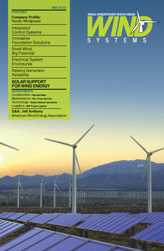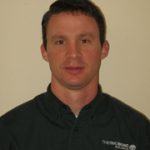Tell us about what AWEA is doing in the wind energy supply chain area.
AWEA has had an active supply chain initiative in place since early 2008. A report from the U.S. Department of Energy called “20% Wind Energy by 2030,” which can be downloaded at www.20percentwind.org, identified supply chain issues—the manufacturing capacity to produce wind turbines and turbine components—as one of the major challenges facing the wind energy industry’s growth in the coming years. So AWEA has made it a priority and spent considerable resources focusing on encouraging wind turbine and component manufacturing, as well as services, transportation, and installation of wind turbine components. The scope of our initiative covers all aspects of the supply chain, from raw materials through completion of installation and commissioning of the wind turbine.
We also recently increased our outreach to our businesses in the supply chain, engaging directly with current and potential members to answer questions and provide information about industry trends and expectations. AWEA has multiple working groups that serve to provide technical support by bringing participants together to identify issues affecting the industry and working to reach consensus on the action needed to move forward. Two of those working groups include the AWEA Transportation & Logistics Working Group and the AWEA Manufacturing Working Group.
How is AWEA helping members learn about and address supply chain issues?
Our website provides a wealth of information that’s being expanded as we compile information into fact sheets. AWEA also hosts several regional supply chain conferences each year, in addition to the supply chain track at our annual WINDPOWER Conference and Exhibition. Participation in these programs is not limited to members of AWEA or affiliated organizations, but is open to all interested parties. Additionally, we’re working to increase engagement with other groups such as the Society of Manufacturing Engineers (SME) to develop programs that benefit our mutual members and the industry as a whole. Efforts are underway to develop a series of webcasts to expand the distribution of wind industry information.
What are the primary supply-chain challenges wind energy companies face?
For manufacturing, developing a domestic supply chain for nacelle components is a priority for many OEMs, and maintaining competitive pricing in line with offshore suppliers is proving to be difficult. One cause is the lack of integrated forging and foundry facilities dedicated to producing wind components. As the components move from raw material to finished component, they change location and service provider, which adds transportation and handling cost and reduces margins.
Another cause is the open capacity that exists due to the drop in orders worldwide. For transportation there is a shortage of cartage equipment, particularly the specialized trailers and rail cars needed to move components and erection equipment. As the number of turbine installations increases annually, demand will outpace supply, yet investments aren’t being made due to market uncertainty. For installation, heavy lift equipment availability has been and will continue to be a challenge, and with few OEMs supplying the world scaling up output is difficult. As hub heights and component weight increase, larger cranes will be required. In coming years the construction of new coal and nuclear plants will create competition for the available rigs.
A primary cause of these challenges is the lack of a national energy policy. The number of installations has been affected as the wind energy Production Tax Credit (PTC) toggles on and off. Without a continuous market, companies have been reluctant to make major investments in assets that would be underutilized. AWEA is lobbying for a Renewable Electricity Standard as a means to provide long-term market stability and predictable demand from a national level, which would provide the necessary signal for investment in the manufacturing sector to address these issues.
For more information: Go to www.awea.org or www.windpowerexpo.org.








































